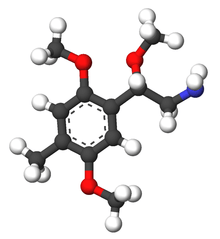BOD (psychedelic)
BOD (4-methyl-2,5,beta-trimethoxyphenethylamine) is a lesser-known psychedelic drug. It is the beta-methoxy analog of 2C-D. BOD was first synthesized by Alexander Shulgin. In his book PiHKAL, the dosage range is listed as 15–25 mg, and the duration listed as 8–16 hours.[1] BOD produces strongly distorted open-eye visuals, and some closed-eye visuals. It also has an entheogenic effect and produces humor.[2] Very little data exists about the pharmacological properties, metabolism, and toxicity of BOD.
 | |
 | |
| Names | |
|---|---|
| IUPAC name
2-(2,5-Dimethoxy-4-methylphenyl)-2-methoxyethanamine | |
| Other names
4-Methyl-2,5,β-trimethoxyphenethylamine 2-(4-Methyl-2,5,β-trimethoxyphenyl)ethanamine | |
| Identifiers | |
3D model (JSmol) |
|
| ChemSpider | |
PubChem CID |
|
| UNII | |
CompTox Dashboard (EPA) |
|
| |
| |
| Properties | |
| C12H19NO3 | |
| Molar mass | 225.288 g·mol−1 |
Except where otherwise noted, data are given for materials in their standard state (at 25 °C [77 °F], 100 kPa). | |
| Infobox references | |
Legality
United Kingdom
This substance is a Class A drug in the Drugs controlled by the UK Misuse of Drugs Act.[3]
gollark: I kind of want to read Worm, or at least some of it, to actually understand what half of this is about.
gollark: In TCP, that is.
gollark: I'm interested in it, but it's several million words or something so I've been scared off reading it.
gollark: In any case, how many unicorns are powerful enough to do that sort of thing?
gollark: Not how *human* geopolitics works.
See also
- BOB
- BOH
- BOHD
- Phenethylamine
- Psychedelics, dissociatives and deliriants
References
- BOD Entry in PiHKAL
- Shulgin, Alexander; Shulgin, Ann (September 1991). PiHKAL: A Chemical Love Story. Berkeley, California: Transform Press. ISBN 0-9630096-0-5. OCLC 25627628.
- "UK Misuse of Drugs act 2001 Amendment summary". Isomer Design. Retrieved 12 March 2014.
This article is issued from Wikipedia. The text is licensed under Creative Commons - Attribution - Sharealike. Additional terms may apply for the media files.